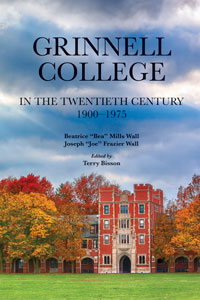by Beatrice Mills Wall ’40 and Joseph Frazier Wall ’41, edited by Terry Bisson ’64
Excerpt from the foreword by Sarah J. Purcell ’92:
Readers of this manuscript can follow the development of themes that were important to the growth and development of Grinnell College from 1900 through approximately 1975: secularization, enrollments and admissions, curriculum changes and development, commitments to social service, political activism, international students and initiatives, town-gown relationships and tensions, athletic competition, tensions over race and gender, student life and social relationships, and the changing physical plant and importance of campus buildings. Two of the most important themes that shape the narrative demonstrate amply that history is never the story of straightforward progress: College finances and the relationships between Grinnell presidents, trustees, faculty, and, to a lesser degree, students and staff. Readers will see how Grinnell College survived at least two eras of financial hardship in the late 1940s/early 1950s and again in the early 1970s, as the financial drama plays out against the story of strong and weak College presidents, struggles over faculty pay and authority, and against a rising tide of student autonomy, protest, and power across the century.

